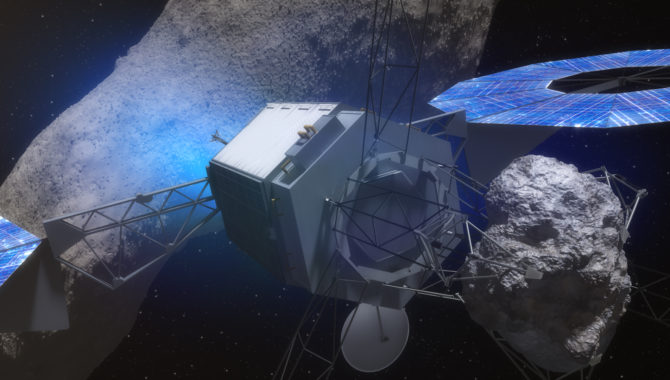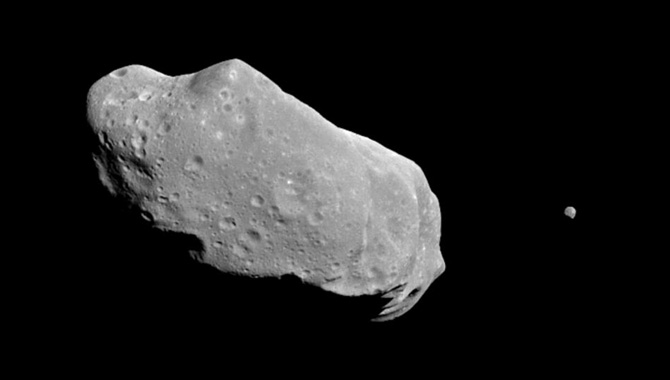
This artist’s concept illustrates a potential option for the robotic segment of the Asteroid Redirect Mission (ARM), in which the spacecraft captures a boulder from a large asteroid and carries it to a distant lunar orbit for in-depth examination.
Image Credit: NASA
In 2013, an asteroid exploded over Siberia with the force of roughly 500 kilotons of TNT. Today, NASA is exploring new planetary defense techniques to protect Earth’s future.
Discussing the 2013 event with NASA Administrator Charles Bolden and Asteroid Redirect Mission (ARM) Program Director Michele Gates, Dr. John P. Holdren said, “That explosion was in the range of thirty times bigger than the Hiroshima nuclear bomb.” Holdren, Assistant to the President for Science and Technology, noted that the asteroid caused extensive damage on the ground as well as injuries to over a thousand people in the region of Chelyabinsk Oblast, Russia.
Despite its strength, the effects of the 2013 blast were minor compared to previous intersections between the earth and asteroids. In 1908, a much larger asteroid exploded over Siberia with, said Holdren, “the equivalent of multiple megatons of explosive force.” Sixty-five million years earlier, the consequences were devastating when an asteroid impacted the Yucatan peninsula, an event that ultimately resulted in the extinction of the dinosaurs.
“The impact that occurred in 2013 is estimated to have been a 1 in 100-year event; the impact that occurred in 1908 was estimated to have been a 1 in 1,000-year event,” said Holdren. “[I]f we are going to be as capable a civilization as our technology allows, we need to be prepared for even those rare events because they could do a lot of damage to the earth.”
Demonstrating technologies related to planetary defense is an aspect of several ongoing and upcoming NASA missions. One such mission is ARM, which will acquire a multi-ton boulder from the surface of an asteroid. “We will then actually use the gravitational mass of that multi-ton boulder and the spacecraft to alter the trajectory of the parent asteroid in a deflection demonstration for planetary defense purposes,” said Gates.
ARM is not the only NASA mission focused on expanding planetary defense capabilities against hazardous asteroids. Earlier this month, NASA launched the Origins, Spectral Interpretation, Resource Identification, Security-Regolith Explorer (OSIRIS-REx) mission. Like ARM, OSIRIS-REx has multiple objectives, one of which is Earth security.
OSIRIS-REx will spend more than two years orbiting and studying the near-Earth asteroid Bennu. That asteroid, whose orbit takes it between Venus and Mars and occasionally crosses paths with Earth, is a potential hazard to our planet. To better understand where the asteroid will be in the future and whether it could present a threat to Earth, one of the objectives of the OSIRIS-REx mission is to learn more about the Yarkovsky effect: a small force exerted by sunlight that causes the orbit of an asteroid to change in ways that are difficult to predict.
“[T]he Yarkovsky effect basically is absorption of solar radiation and the emission of heat that acts like a thruster and actually changes the trajectory of the asteroid beyond what Kepler’s laws would predict,” said Dante Lauretta, OSIRIS-REx principal investigator from the University of Arizona in Tucson, before the launch. “So if you want to know where it’s going to be in the future—and we do with this object—then you’ve got to have this part of the equation. And we’re going to measure that very precisely with our mission.”
“So we have two antennas on the spacecraft: we have a high gain and low gain antenna. And we will use those to track the position of the asteroid as we’re flying in formation with it,” said Daniella DellaGiustina, OSIRIS-REx lead image processing scientist at the University of Arizona in Tucson. “[A]ny small changes from what we anticipate the orbit of Bennu to be versus what we’re tracking will be used to measure that small Yarkovsky effect.”
“[T]his aids us in a whole series of ways,” said NASA Planetary Division director Jim Green after the launch. “One: it helps us to do a better job in determining the exact orbit over several centuries. Two: it enables us to use what we’ve learned on a whole class of asteroids to predict their orbits to determine if they’re even more hazardous than we thought they were. So it’s a huge step for us all the way around.” Findings from the mission about the Yarkovsky effect will be used to determine where other potentially Earth-threatening asteroids will be in the future as well.
Ellen Stofan, talking with NASA Office of Communications’ Joshua Finch before the OSIRIS-REx launch, emphasized the link between the two missions. “Asteroids have hit this planet in the past and they will hit us again at some point in the future. The Asteroid Redirect Mission tests technologies, like solar electric propulsion, that we’re going to use to get cargo out to astronauts who will someday be out at Mars. We’re also going to be testing techniques that will help us understand how we might, in the future, potentially deflect a hazardous asteroid,” she said. “And OSIRIS-REx is really the first step. It’s teaching us how do we get to a small body, how do we maneuver around it, how do we get a sample back. It’s the first step. The Asteroid Redirect Mission is the next step.”
Both missions have multiple objectives that go beyond planetary defense. ARM, for example, is integral to the agency’s journey to Mars as well as to developing capabilities that could be used in mining asteroids for resources.
“[ARM] makes sense in about five different ways,” said Holdren. “It makes sense for science: for better understanding of the composition of asteroids and what they can tell us about the origins of the solar system. It makes sense from the standpoint of technology demonstration: demonstrating technologies that we’re going to need for the mission to Mars. It makes sense in terms of human operations in cis-lunar space…the most appropriate stepping off point for Mars. And it makes sense for the possibilities of using asteroids as sources of materials—potentially sources of fuel, sources of water—to resupply space missions and ultimately to meet needs on Earth. So this is a multi-purpose mission, but the planetary defense aspect is one important part of it.”
OSIRIS-REx is also focused on advancing understanding of the origins of the solar system as well as proving technologies and operational procedures that may be used for asteroid-mining endeavors. OSIRIS-REx information, said Bolden, “will feed into the subsequent Asteroid Redirect Mission. So everything we do is incrementally planned to support each other.”
Together, the two missions will propel the agency forward in multiple ways, from advancing understanding of the origins of our planet to proving technologies that will make it possible to push human presence farther into the solar system and, eventually, to Mars. Some of their greatest benefits, however, will be felt closest to home as they help the agency enhance the security of Earth by uncovering more about the asteroids around us.
Watch an animated video depicting the planned trajectory and rendezvous with an asteroid of ARM’s robotic mission as well as subsequent crew operations incorporating the Space Launch System (SLS) and Orion.
Read an APPEL News article about ARM.
Read an APPEL News article about the launch of the OSIRIS-REx mission.
Read an APPEL News article about NASA’s asteroid hunter NEOWISE.









